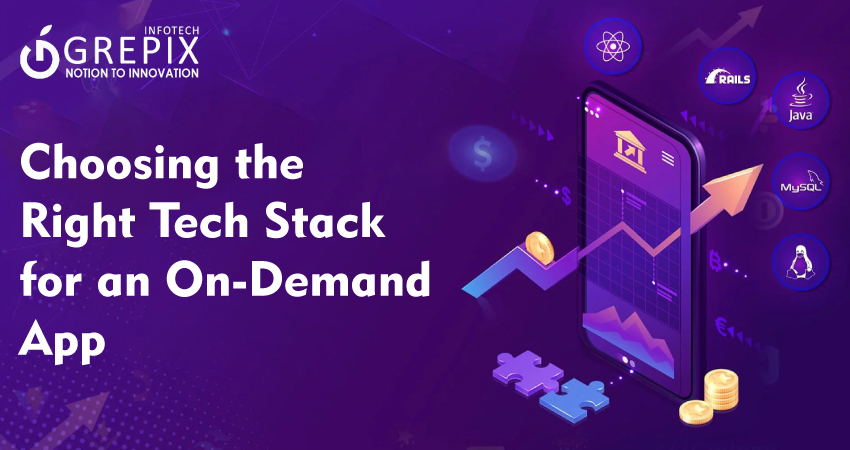Choosing the Right Tech Stack for an On-Demand App
Selecting the perfect tech stack for on-demand apps is vital for building scalable, secure, and high-performance solutions that meet modern user expectations. Whether launching a food delivery, ride-sharing, or healthcare app, your stack drives efficiency, design, and future growth. This guide covers every layer frontend, backend, databases, APIs, and scalability unlocking the best frameworks and app backend technology for transactional and informational search intent.
Choosing the right tech stack for on-demand apps involves balancing technical requirements, budget, and business goals. Start by understanding core needs, user platforms, and scalability demands. Top frameworks like Flutter and React Native simplify front-end design, while backend solutions like Node.js and Django ensure secure, real-time operations. Database choices like MongoDB and PostgreSQL provide reliability and speed, while third-party APIs enable payments, notifications, and social logins. Real-life use cases (UberEats, Airbnb, Wix) and statistics demonstrate the impact of choosing the right stack on performance and growth. Ultimately, a thoughtful tech stack decision sets your app up for long-term success, user satisfaction, and seamless expansion.
1Why Tech Stack Matters for On-Demand Apps
A tech stack represents the combination of languages, frameworks, databases, cloud platforms, and third-party integrations that power your app’s features and performance.
- Impacts scalability, development speed, costs, and user experience.
- Determines ease of maintenance, security, and future updates.
- Influences market success and business growth.
2Frontend Frameworks: Best Frameworks for Apps
Key Frontend Technologies
The frontend is where users interact directly with your app. Choosing the right technology ensures seamless experience across devices and platforms.
Popular Frameworks:
- React.js: Modular, component-based structure, vast ecosystem, and strong support for cross-platform apps. Used by Facebook, Instagram, Airbnb.
- Angular: Scalability and enterprise strength; used for dynamic UIs and responsive designs.
- Flutter: Native performance on iOS/Android with speedy time-to-market. Ideal for startups and MVPs.
- Vue.js: Lightweight and flexible; suitable for complex, interactive interfaces.
Key Features:
- Device responsiveness and cross-platform support.
- Speedy updates and modular architecture.
- Integration with backend and APIs.
Real-World Example
- Wix: Shares 95% of its codebase between iOS and Android using React Native, enabling rapid deployment and cohesive user experiences.
- Pinterest: Migrated key features to React Native, speeding up development and lowering overhead.
3Backend Frameworks: App Backend Technology
Critical Backend Frameworks for On-Demand Apps
The backend manages business logic, user data, processing, and integrations. The right backend is essential for security, speed, and scalability.
Top Frameworks:
- Node.js: Asynchronous, event-driven; handles real-time operations (chat, notifications, streaming). Favored for high-concurrency and microservices.
- Django (Python): Security features, scalability, and rapid development. Used for complex business logic, secure authentication, and API management.
- Ruby on Rails: Fast prototyping, great for startups needing rapid launch.
- Spring Boot (Java): Enterprise-grade reliability and scalability.
- Serverless Architecture: Cloud-first, elastic scalability using AWS Lambda, Google Cloud Functions, and Azure Functions for event-driven apps.
Programming Languages:
- Python: Easy to learn, supports server frameworks.
- JavaScript (Node.js): Handles APIs and server operations.
- Ruby: Clean syntax, supports rapid development.
Real-World Example
- Uber: Uses native stacks (Objective-C, Swift, Java, Kotlin) and combines them with RxJava and Retrofit for backend services.
- Airbnb: Hybrid stack React Native for frontend, with Django backend for business logic and API management.
4Database Choices for On-Demand Apps
Choosing the Best Database
Databases are the backbone for storing user, transaction, and analytics data. The selection depends on app complexity, transaction volume, and scalability requirements.
Key Database Solutions:
- MongoDB: NoSQL, ideal for scaling and handling large user bases. Used for real-time tracking, personalized recommendations.
- Firebase: Real-time NoSQL database; comes with built-in authentication, widely used for MVPs.
- PostgreSQL: Robust, open-source relational database with advanced security for regulated industries.
- MySQL: Reliable, widely-supported; good for transactional integrity.
Integration Tips
- Ensure 24/7 availability and robust security.
- Select database type (SQL/NoSQL) based on need for structure or flexibility.
- For MVPs Firebase or MongoDB is recommended.
- For high compliance PostgreSQL or MySQL is better.
Also Read: "Cost Optimization: How On-Demand Apps Can Reduce Operational Expenses"
5Third-Party APIs and Integrations
Essential APIs for On-Demand Apps
APIs are pivotal for extending app functionality enabling payments, notifications, social logins, and analytics.
Top Third-Party Integrations:
- Social Media: Facebook, Instagram, Twitter API for login and sharing.
- Payment Gateways: Stripe, PayPal, Razorpay, Authorize.net for secure, easy transactions.
- Maps & Geolocation: Google Maps API, Mapbox track deliveries, rides, locations.
- Push Notifications: Firebase Cloud Messaging (FCM), Twilio engage users.
- CRM: Zoho, Salesforce, Microsoft Dynamics analyze and optimize customer relationships.
Implementation Considerations
- Pre-built APIs shorten development time.
- Provide enhanced user experiences.
- Improve retention and upsell opportunities.
6Scalability: Building for Growth
How the Best Tech Stack Enables Growth
Scalability is crucial for on-demand apps, which must handle spikes in user demand, new feature rollouts, and market expansion.
Scalable Architecture Essentials:
- Cloud Hosting: AWS, Google Cloud, Azure provide elastic resources, automatic scaling, and fail-safe redundancy.
- Serverless Computing: Scales apps automatically, reduces cost and downtime, and simplifies maintenance.
- Microservices: Divide app into modular services for easier scaling and fault tolerance.
Development Practices:
- Use CI/CD for automated deployment, testing, and scaling.
- Monitor performance, optimize bottlenecks, and refactor code proactively.
Statistics and Case Studies
- On-demand economy projected to reach $335 billion by 2025 scalable tech stacks meet this demand.
- Facebook, Uber, and Airbnb scale using modular stacks and serverless approaches, deploying new features globally without disruption.
Conclusion
Choosing the right tech stack for on-demand apps isn’t just a technical decision. it’s a strategic one that influences your business’s scalability, innovation, and success. The best frameworks for apps today are those that balance development speed, robustness, and user-centric design. From frontend interfaces (React Native) to backend engines (Node.js) and future-proofed infrastructures (AWS, Google Cloud), every layer must be chosen with your business logic, security, and scaling ambitions in mind.
FAQs
1. What is the tech stack for on-demand apps?
The stack includes front-end frameworks (React, Angular, Flutter), backend technologies (Node.js, Django, Ruby), databases (MongoDB, PostgreSQL), cloud platforms (AWS, Azure), and APIs for payments/social integration.
2. How do I choose the best frameworks for apps?
Assess your team’s expertise, target platforms, scalability needs, and app complexity. Flutter and React Native lead for cross-platform; native stacks work for high-performance apps.
3. Why is backend technology important for on-demand apps?
It powers business logic, secure transactions, user authentication, and scaling Node.js and Django are top backend frameworks for modern apps.
4. How much does it cost to build an on-demand app?
Costs vary by complexity basic: $20,000–$65,000, average: $60,000–$140,000, advanced: $75,000–$200,000.
5. What third-party integrations are most useful?
Integrate APIs for payments (Stripe, PayPal), maps (Google Maps), notifications (FCM, Twilio), and CRM (Salesforce, Zoho) for maximum functionality and user retention.
Launch your vision with our mobile app development company, where innovation meets excellence to create cutting edge mobile solutions.







